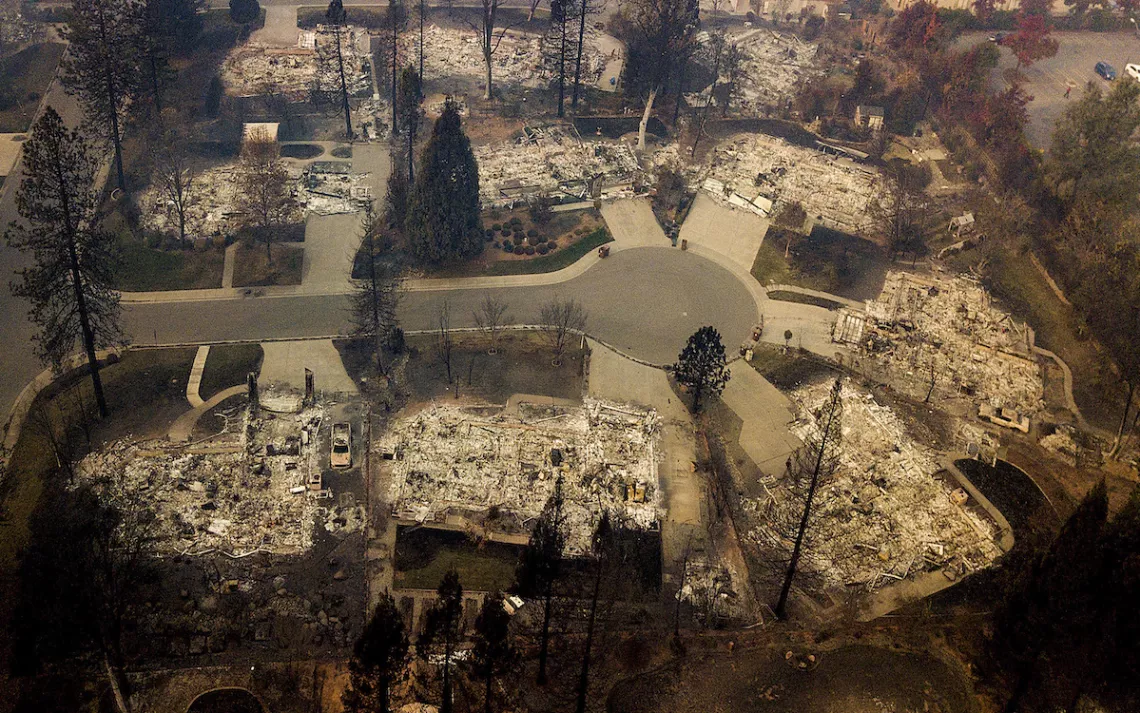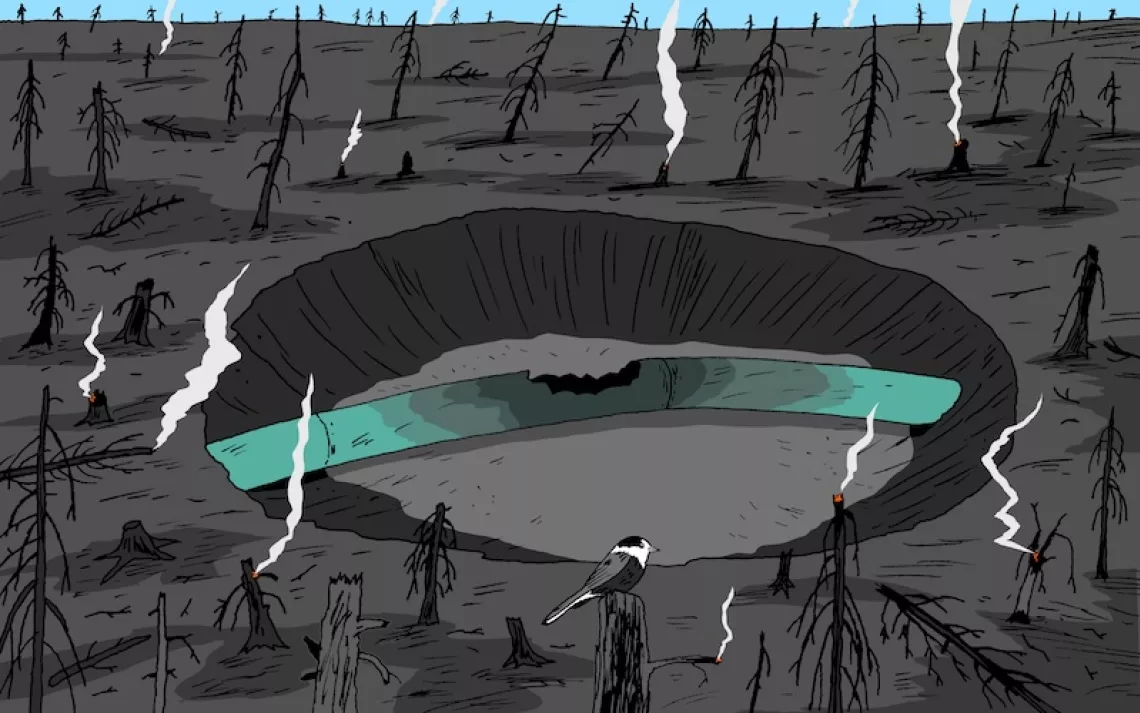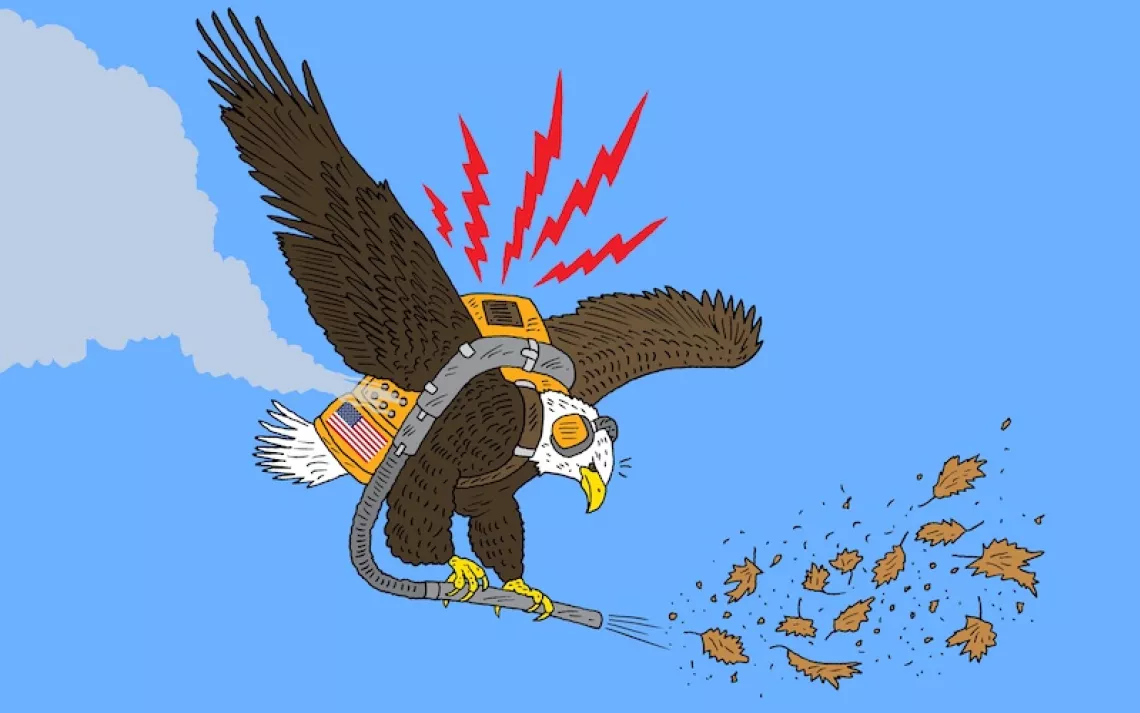According to the 4th National Climate Assessment, Inaction on Global Warming Will Be Catastrophic
Trump administration officials attempt to bury the report on Black Friday

Residences leveled by the Camp Fire line a cul-de-sac in Paradise, California. | Photo by AP Photo/Noah Berger
The nation’s leading federal scientists gave new meaning to “Black Friday” last week when they released the starkest warning yet, that without immediate action, global warming will fundamentally transform the United States—a warning so precise in its calculus that an attempt to bury the news during a holiday was little more than a distraction.
As families and friends across the country enjoyed the Thanksgiving break, the Trump administration released the fourth National Climate Assessment, choosing to do so on the busiest shopping day of the year in a transparent attempt to hide it from media scrutiny. The effort failed: Scientists, journalists, and leaders in government and the private sector across the country and around the world moved quickly to broadcast the climate assessment and its dire findings dominated headlines over the weekend.
The report is the federal government’s clearest statement to date that the reckless burning of fossil fuels for the last two centuries has put the nation on a collision course with a variety of near-biblical planetary consequences, from extreme drought and massive storms to monster wildfires, sea level rise, and the multiplication of dangerous diseases. Those consequences, the assessment makes clear, are not for future generations to experience at some distant date. They are already here, with nightmare scenarios unfolding within our lifetimes unless leaders act now.
“The assumption that current and future climate conditions will resemble the recent past is no longer valid,” the report authors write. “Observations collected around the world provide significant, clear, and compelling evidence that global average temperature is much higher, and is rising more rapidly than anything modern civilization has experienced, with widespread and growing impacts. . . . Climate change is transforming where and how we live and presents growing challenges to human health and quality of life, the economy, and the natural systems that support us.”
The massive 1,656-page report, assembled by scientists from 13 federal agencies and released by the United States Global Change Research Program, is a congressionally mandated peer-reviewed assessment of the available data on how anthropogenic greenhouse gases such as carbon dioxide, methane, and nitrous oxide are impacting the climate system. The assessment is the product of eight rounds of review, including a public review and comment period and an expert peer-review process. It was written by more than 300 authors. About half of the authors come from outside the federal government, including from state and tribal government, academia, and the private sector.
The assessment’s release is required by law. In 1990, under President George H. W. Bush, Congress passed the Global Change Research Act, which requires agencies across the government to study the impacts of global warming and release a report every four years. The first report was released in 2000; the fourth has been released in two volumes. The first was released in November 2017 and focused on the physical climate. Volume II of the assessment released on Friday focuses on the risks and vulnerabilities associated with global warming and the adaptation and mitigation strategies required to deal with them.
The assessment paints a grim picture: Global warming will lead to devastating consequences for the economy, public health, a wide variety of already endangered species, and the environment overall. Droughts will get worse, crop scarcity will become more common, and supply chains will be disrupted. The cost of continued inaction, the assessment makes clear, will lead to social disruption, economic damage, and public health impacts on a scale never before witnessed by modern society.
“Without significant reduction in greenhouse gas emissions, extinctions and transformative impacts on some ecosystems cannot be avoided, with varying impacts on the economic, recreational, and subsistence activities they support,” Dr. David Easterling, director of the Technical Support Unit at the NOAA National Centers for Environmental Information, said during a conference call with journalists on Friday immediately following the assessment’s release. “Higher temperatures, increased air-quality risks, more frequent and intense extreme weather and climate-related events, increases in coastal flooding, disruption of ecosystem services, and other changes increasingly threaten the health and well-being of the American people.”
The report breaks down the impacts of climate change across every region of the United States, making clear that no place will be left unaffected. Projected extreme heat waves will lead to more premature deaths, hospital admissions, and emergency department visits in the Northeast. In the Southeast, the combined effects of extreme rainfall and sea level rise will precipitate scenarios in which, by 2100, low-lying areas will suffer from extreme tidal flooding on a daily basis. “Under higher emissions scenarios, global sea level rise exceeding eight feet (and even higher in the Southeast) by 2100 cannot be ruled out,” according to the report.
In the Southwest and California, where monster wildfires like the recent Camp Fire led to nearly 100 deaths and counting, extreme drought, depleting groundwater, and aging infrastructure will collide with a growing population, leading to water shortages, more wildfires, and megadroughts (dry periods lasting 10 years or more). In the U.S. Caribbean, hurricanes, extreme rainfall, and droughts will cost billions of dollars in damages to crops and property. “The estimated damages for Hurricane Maria alone totaled between $27 and $48 billion for the Caribbean region, with Puerto Rico estimates ranging from $25 to $43 billion (in 2017 dollars),” according to the report.
The dangers from extreme heat are a consistent theme throughout the assessment. Heat waves are responsible for the largest number of weather-related deaths in the United States and in Europe. Nighttime low temperatures are rising, which will have a huge impact on agriculture and a large economic impact on the region.
“From a climate perspective, there’s no evidence that the persistent drought conditions in the West are going to get better,” Ben Kirtman, professor of atmospheric sciences at the University of Miami's Rosenstiel School of Marine and Atmospheric Science and the director of the NOAA Cooperative Institute for Marine and Atmospheric Studies, said in an interview. He is the author and/or coauthor of over 100 peer-reviewed papers on climate variability. “There’s a ton of evidence that those persistent conditions are going to continue to get worse, that the snowpack is going to reduce, the stream flows are going to reduce, the water demand is going to increase, there’s going to be less irrigation available. And we’re going to be dealing with more wildfires as time goes on.”
The fourth National Climate Assessment is notable for its clarity in presenting the economic consequences of global warming. For the first time, the NCA puts a comprehensive economic cost of inaction on top of the risks and vulnerabilities associated with climate change. According to the findings, 10 percent of the nation’s gross domestic product will be shorn off by 2100 if nothing is done to mitigate the worst impacts.
That number is just one example of how the latest assessment clarifies the enormous cost of inaction, according to Kirtman. “The survival of our nation is based on small percentages,” he said. “If you shave off 10 percent of the economy, there will be catastrophic effects. For too long the economic interests of continuing business as usual has dominated the discussion. What this report does is help rebalance that so we can think about, what are the costs to the country as a whole of inaction, of not trying to reduce carbon emissions.”
Particularly alarming is the assessment’s finding that climate change is already outpacing climate-adaptation strategies, making clear that not enough is being done to prepare for the worst consequences of global warming. The report also examines how low-income communities and communities of color remain the most vulnerable, with cascading impacts. “Tribal trust lands provide habitat for more than 525 species listed under the Endangered Species Act, and more than 13,000 miles of rivers and 997,000 lakes are located on federally recognized tribal lands,” the report states. All will be impacted by extreme climate conditions.
The assessment was originally scheduled to be released around the American Geophysical Union’s meeting in Washington, D.C., next month. Instead, the administration changed course, directing its release on Black Friday, with barely a week’s notice. During the conference call on Friday to release the report, experts and administration officials made available for comment struggled to explain why one of the most exigent climate assessments the country had ever produced was being released on one of the slowest news days of the year, when most people were spending time with their friends and families. “We ask you to focus on the substance of the report, which is so important to the American public [and not the timing],” NOAA spokeswoman Monica Allen said.
The NCA was paired with another government report, the Second State of the Carbon Cycle Report, which revealed that the United States has made progress in drawing down greenhouse gas emissions in the past two decades, thanks mainly to the transition away from coal. But many of those improvements are now threatened as the Trump administration continues its efforts to force a realignment of the nation’s energy strategy toward coal, oil, and gas.
Brenda Ekwurzel, the director of climate science at the Union of Concerned Scientists and one of the authors of the assessment, said in a statement, “This report makes it clear that climate change is not some problem in the distant future. It’s happening right now in every part of the country. When people say the wildfires, hurricanes, and heat waves they’re experiencing are unlike anything they’ve seen before, there’s a reason for that, and it’s called climate change.”
Kirtman said that if we don’t start moving toward serious adaptation and mitigation at the same time, the country is on a bad trajectory. But he remains optimistic. “That mountain of evidence just keeps on building,” he said. “To me it’s more than enough evidence. Eventually, we’ll be able to convince everybody.”
 The Magazine of The Sierra Club
The Magazine of The Sierra Club







